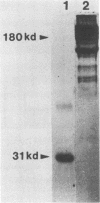Abstract
The adherence of Streptococcus sanguis to specific receptors exposed or deposited at the site of endothelial damage may play an important role in the development of infective endocarditis. Adherence of the Challis strain of S. sanguis to gelatin (or collagen) and gelatin-binding components of plasma was examined with an enzyme-linked immunosorbent assay. S. sanguis adhered poorly to immobilized gelatin and to molecular or fibrillar collagen. However, in the presence of fresh human plasma, the adherence of S. sanguis to all three substrates increased as much as eightfold. Removal of gelatin-binding proteins eliminates the ability of plasma to enhance adherence of S. sanguis to the substrates. Addition of purified human plasma fibronectin (Fn) to the absorbed plasma restored the adherence-promoting ability in a dose-dependent manner. A similar dose-dependent increase in S. sanguis adherence was observed when increasing concentrations of Fn alone were added to the gelatin-coated assay wells. S. sanguis adherence to immobilized fibronectin could not be inhibited by preincubating either the bacteria or the gelatin-coated assay wells with Fn or by including excess soluble Fn in the assay mixture. Studies with peptides purified from trypsin digests of Fn indicated that the 160- to 180-kilodalton (kDa) fragments which retain both the gelatin-binding and the cell-binding regions of the intact molecule support adherence of S. sanguis to gelatin. The 160- to 180-kDa fragments inhibited the interaction of S. sanguis with immobilized Fn. In contrast, intact Fn and the 31-kDa amino-terminal fragment were unable to inhibit the adherence when used in equivalent or greater molar amounts. These in vitro results suggest that in the presence of whole plasma, S. sanguis binds to immobilized gelatin or collagen via Fn bound to the immobilized substrates. Our finding that adherence of S. sanguis to immobilized Fn can occur in the presence of large concentrations of Fn, whether in plasma or purified, indicates that a S. sanguis-binding domain is cryptic in the Fn molecule while in solution and is exposed by a conformational change when the Fn becomes bound to gelatin-coated plastic. The ability of peptide fragments of Fn to inhibit S. sanguis adherence is consistent with this hypothesis.
Full text
PDF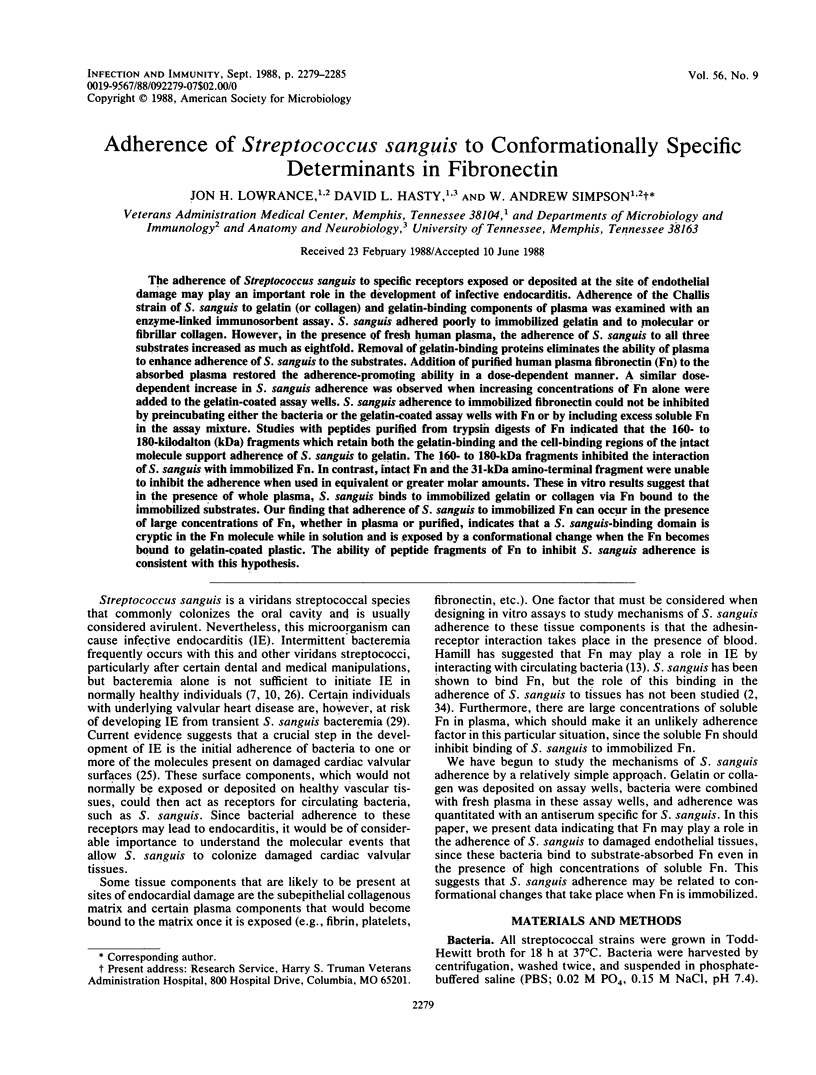
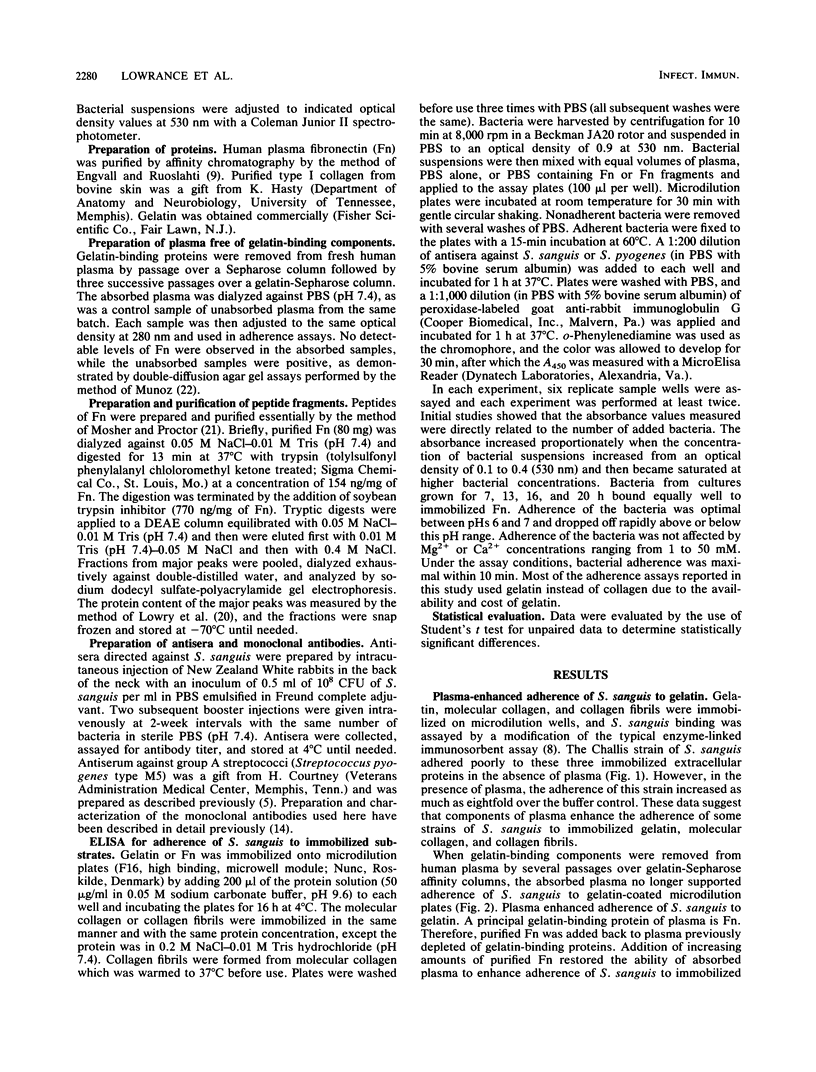



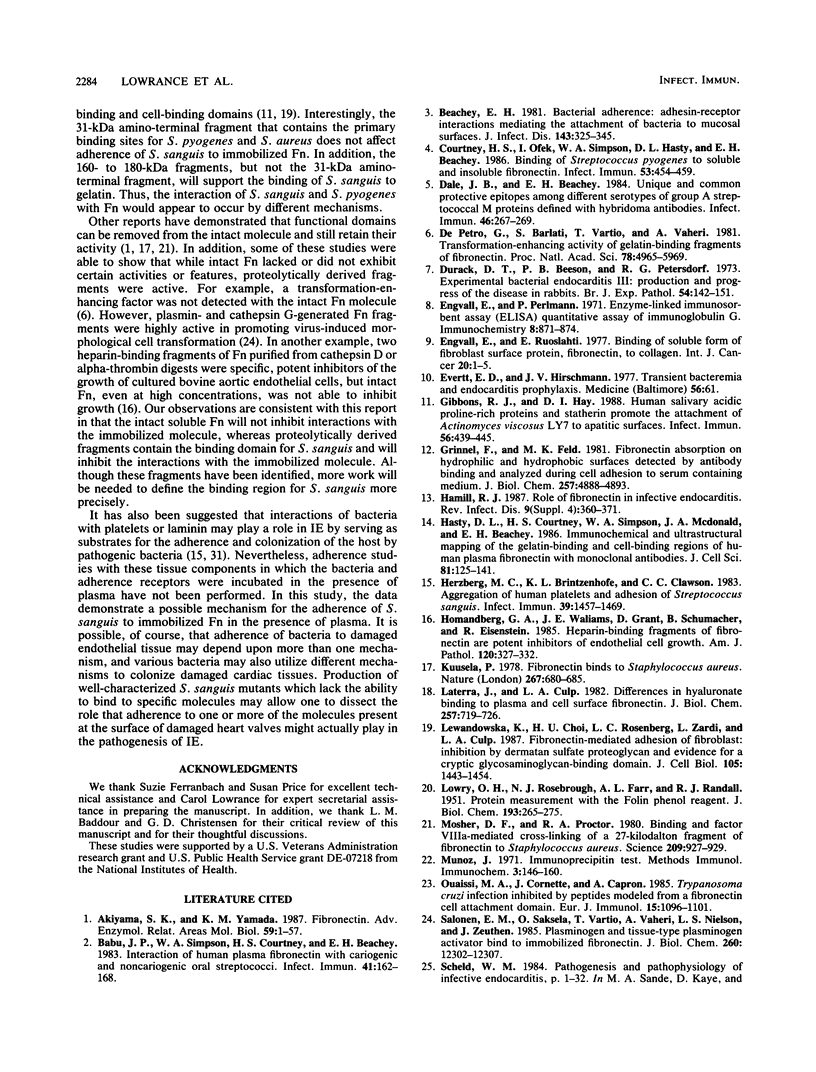
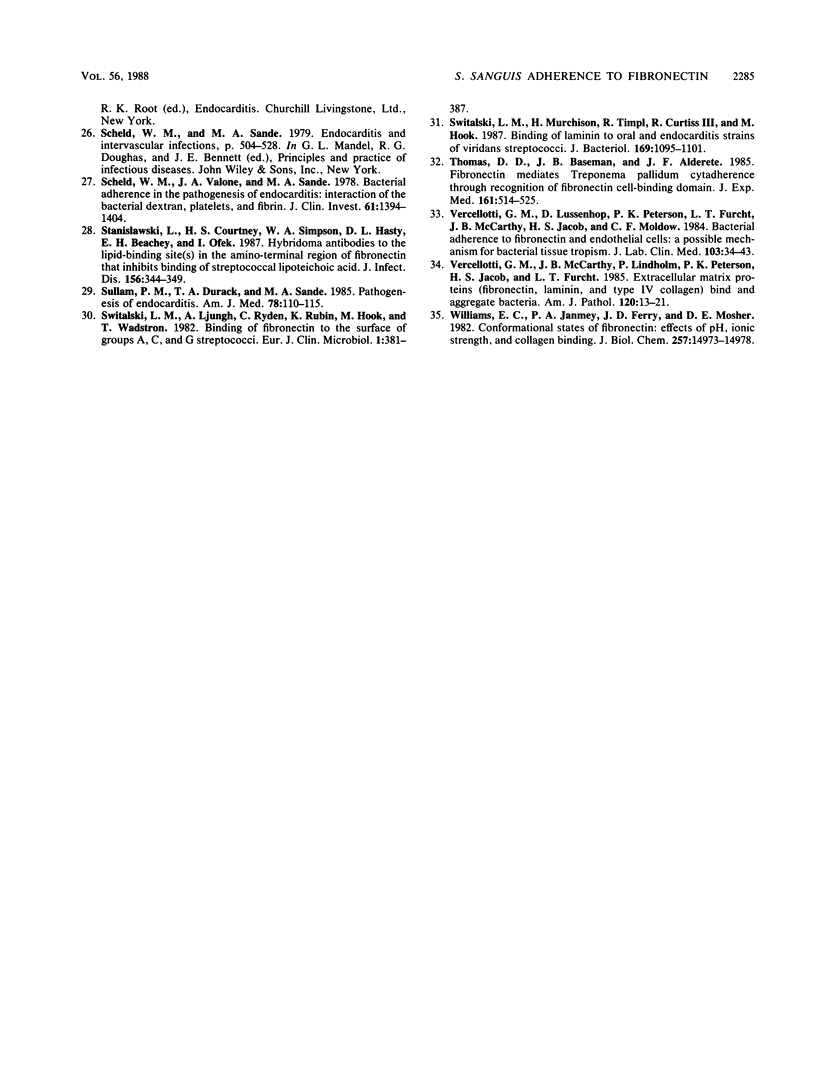
Images in this article
Selected References
These references are in PubMed. This may not be the complete list of references from this article.
- Akiyama S. K., Yamada K. M. Fibronectin. Adv Enzymol Relat Areas Mol Biol. 1987;59:1–57. doi: 10.1002/9780470123058.ch1. [DOI] [PubMed] [Google Scholar]
- Babu J. P., Simpson W. A., Courtney H. S., Beachey E. H. Interaction of human plasma fibronectin with cariogenic and non-cariogenic oral streptococci. Infect Immun. 1983 Jul;41(1):162–168. doi: 10.1128/iai.41.1.162-168.1983. [DOI] [PMC free article] [PubMed] [Google Scholar]
- Beachey E. H. Bacterial adherence: adhesin-receptor interactions mediating the attachment of bacteria to mucosal surface. J Infect Dis. 1981 Mar;143(3):325–345. doi: 10.1093/infdis/143.3.325. [DOI] [PubMed] [Google Scholar]
- Courtney H. S., Ofek I., Simpson W. A., Hasty D. L., Beachey E. H. Binding of Streptococcus pyogenes to soluble and insoluble fibronectin. Infect Immun. 1986 Sep;53(3):454–459. doi: 10.1128/iai.53.3.454-459.1986. [DOI] [PMC free article] [PubMed] [Google Scholar]
- Dale J. B., Beachey E. H. Unique and common protective epitopes among different serotypes of group A streptococcal M proteins defined with hybridoma antibodies. Infect Immun. 1984 Oct;46(1):267–269. doi: 10.1128/iai.46.1.267-269.1984. [DOI] [PMC free article] [PubMed] [Google Scholar]
- De Petro G., Barlati S., Vartio T., Vaheri A. Transformation-enhancing activity of gelatin-binding fragments of fibronectin. Proc Natl Acad Sci U S A. 1981 Aug;78(8):4965–4969. doi: 10.1073/pnas.78.8.4965. [DOI] [PMC free article] [PubMed] [Google Scholar]
- Durack D. T., Beeson P. B., Petersdorf R. G. Experimental bacterial endocarditis. 3. Production and progress of the disease in rabbits. Br J Exp Pathol. 1973 Apr;54(2):142–151. [PMC free article] [PubMed] [Google Scholar]
- Engvall E., Perlmann P. Enzyme-linked immunosorbent assay (ELISA). Quantitative assay of immunoglobulin G. Immunochemistry. 1971 Sep;8(9):871–874. doi: 10.1016/0019-2791(71)90454-x. [DOI] [PubMed] [Google Scholar]
- Engvall E., Ruoslahti E. Binding of soluble form of fibroblast surface protein, fibronectin, to collagen. Int J Cancer. 1977 Jul 15;20(1):1–5. doi: 10.1002/ijc.2910200102. [DOI] [PubMed] [Google Scholar]
- Everett E. D., Hirschmann J. V. Transient bacteremia and endocarditis prophylaxis. A review. Medicine (Baltimore) 1977 Jan;56(1):61–77. [PubMed] [Google Scholar]
- Gibbons R. J., Hay D. I. Human salivary acidic proline-rich proteins and statherin promote the attachment of Actinomyces viscosus LY7 to apatitic surfaces. Infect Immun. 1988 Feb;56(2):439–445. doi: 10.1128/iai.56.2.439-445.1988. [DOI] [PMC free article] [PubMed] [Google Scholar]
- Grinnell F., Feld M. K. Fibronectin adsorption on hydrophilic and hydrophobic surfaces detected by antibody binding and analyzed during cell adhesion in serum-containing medium. J Biol Chem. 1982 May 10;257(9):4888–4893. [PubMed] [Google Scholar]
- Hasty D. L., Courtney H. S., Simpson W. A., McDonald J. A., Beachey E. H. Immunochemical and ultrastructural mapping of the gelatin-binding and cell-attachment regions of human plasma fibronectin with monoclonal antibodies. J Cell Sci. 1986 Mar;81:125–141. doi: 10.1242/jcs.81.1.125. [DOI] [PubMed] [Google Scholar]
- Herzberg M. C., Brintzenhofe K. L., Clawson C. C. Aggregation of human platelets and adhesion of Streptococcus sanguis. Infect Immun. 1983 Mar;39(3):1457–1469. doi: 10.1128/iai.39.3.1457-1469.1983. [DOI] [PMC free article] [PubMed] [Google Scholar]
- Homandberg G. A., Williams J. E., Grant D., Schumacher B., Eisenstein R. Heparin-binding fragments of fibronectin are potent inhibitors of endothelial cell growth. Am J Pathol. 1985 Sep;120(3):327–332. [PMC free article] [PubMed] [Google Scholar]
- LOWRY O. H., ROSEBROUGH N. J., FARR A. L., RANDALL R. J. Protein measurement with the Folin phenol reagent. J Biol Chem. 1951 Nov;193(1):265–275. [PubMed] [Google Scholar]
- Laterra J., Culp L. A. Differences in hyaluronate binding to plasma and cell surface fibronectins. Requirement for aggregation. J Biol Chem. 1982 Jan 25;257(2):719–726. [PubMed] [Google Scholar]
- Lewandowska K., Choi H. U., Rosenberg L. C., Zardi L., Culp L. A. Fibronectin-mediated adhesion of fibroblasts: inhibition by dermatan sulfate proteoglycan and evidence for a cryptic glycosaminoglycan-binding domain. J Cell Biol. 1987 Sep;105(3):1443–1454. doi: 10.1083/jcb.105.3.1443. [DOI] [PMC free article] [PubMed] [Google Scholar]
- Mosher D. F., Proctor R. A. Binding and factor XIIIa-mediated cross-linking of a 27-kilodalton fragment of fibronectin to Staphylococcus aureus. Science. 1980 Aug 22;209(4459):927–929. doi: 10.1126/science.7403857. [DOI] [PubMed] [Google Scholar]
- Ouaissi M. A., Cornette J., Capron A. Trypanosoma cruzi: modulation of parasite-cell interaction by plasma fibronectin. Eur J Immunol. 1985 Nov;15(11):1096–1101. doi: 10.1002/eji.1830151106. [DOI] [PubMed] [Google Scholar]
- Salonen E. M., Saksela O., Vartio T., Vaheri A., Nielsen L. S., Zeuthen J. Plasminogen and tissue-type plasminogen activator bind to immobilized fibronectin. J Biol Chem. 1985 Oct 5;260(22):12302–12307. [PubMed] [Google Scholar]
- Scheld W. M., Valone J. A., Sande M. A. Bacterial adherence in the pathogenesis of endocarditis. Interaction of bacterial dextran, platelets, and fibrin. J Clin Invest. 1978 May;61(5):1394–1404. doi: 10.1172/JCI109057. [DOI] [PMC free article] [PubMed] [Google Scholar]
- Stanislawski L., Courtney H. S., Simpson W. A., Hasty D. L., Beachey E. H., Robert L., Ofek I. Hybridoma antibodies to the lipid-binding site(s) in the amino-terminal region of fibronectin inhibits binding of streptococcal lipoteichoic acid. J Infect Dis. 1987 Aug;156(2):344–349. doi: 10.1093/infdis/156.2.344. [DOI] [PubMed] [Google Scholar]
- Sullam P. M., Drake T. A., Sande M. A. Pathogenesis of endocarditis. Am J Med. 1985 Jun 28;78(6B):110–115. doi: 10.1016/0002-9343(85)90373-0. [DOI] [PubMed] [Google Scholar]
- Switalski L. M., Ljungh A., Rydén C., Rubin K., Hök M., Wadström T. Binding of fibronectin to the surface of group A, C, and G streptococci isolated from human infections. Eur J Clin Microbiol. 1982 Dec;1(6):381–387. doi: 10.1007/BF02019939. [DOI] [PubMed] [Google Scholar]
- Switalski L. M., Murchison H., Timpl R., Curtiss R., 3rd, Hök M. Binding of laminin to oral and endocarditis strains of viridans streptococci. J Bacteriol. 1987 Mar;169(3):1095–1101. doi: 10.1128/jb.169.3.1095-1101.1987. [DOI] [PMC free article] [PubMed] [Google Scholar]
- Thomas D. D., Baseman J. B., Alderete J. F. Fibronectin mediates Treponema pallidum cytadherence through recognition of fibronectin cell-binding domain. J Exp Med. 1985 Mar 1;161(3):514–525. doi: 10.1084/jem.161.3.514. [DOI] [PMC free article] [PubMed] [Google Scholar]
- Vercellotti G. M., Lussenhop D., Peterson P. K., Furcht L. T., McCarthy J. B., Jacob H. S., Moldow C. F. Bacterial adherence to fibronectin and endothelial cells: a possible mechanism for bacterial tissue tropism. J Lab Clin Med. 1984 Jan;103(1):34–43. [PubMed] [Google Scholar]
- Vercellotti G. M., McCarthy J. B., Lindholm P., Peterson P. K., Jacob H. S., Furcht L. T. Extracellular matrix proteins (fibronectin, laminin, and type IV collagen) bind and aggregate bacteria. Am J Pathol. 1985 Jul;120(1):13–21. [PMC free article] [PubMed] [Google Scholar]
- Williams E. C., Janmey P. A., Ferry J. D., Mosher D. F. Conformational states of fibronectin. Effects of pH, ionic strength, and collagen binding. J Biol Chem. 1982 Dec 25;257(24):14973–14978. [PubMed] [Google Scholar]



